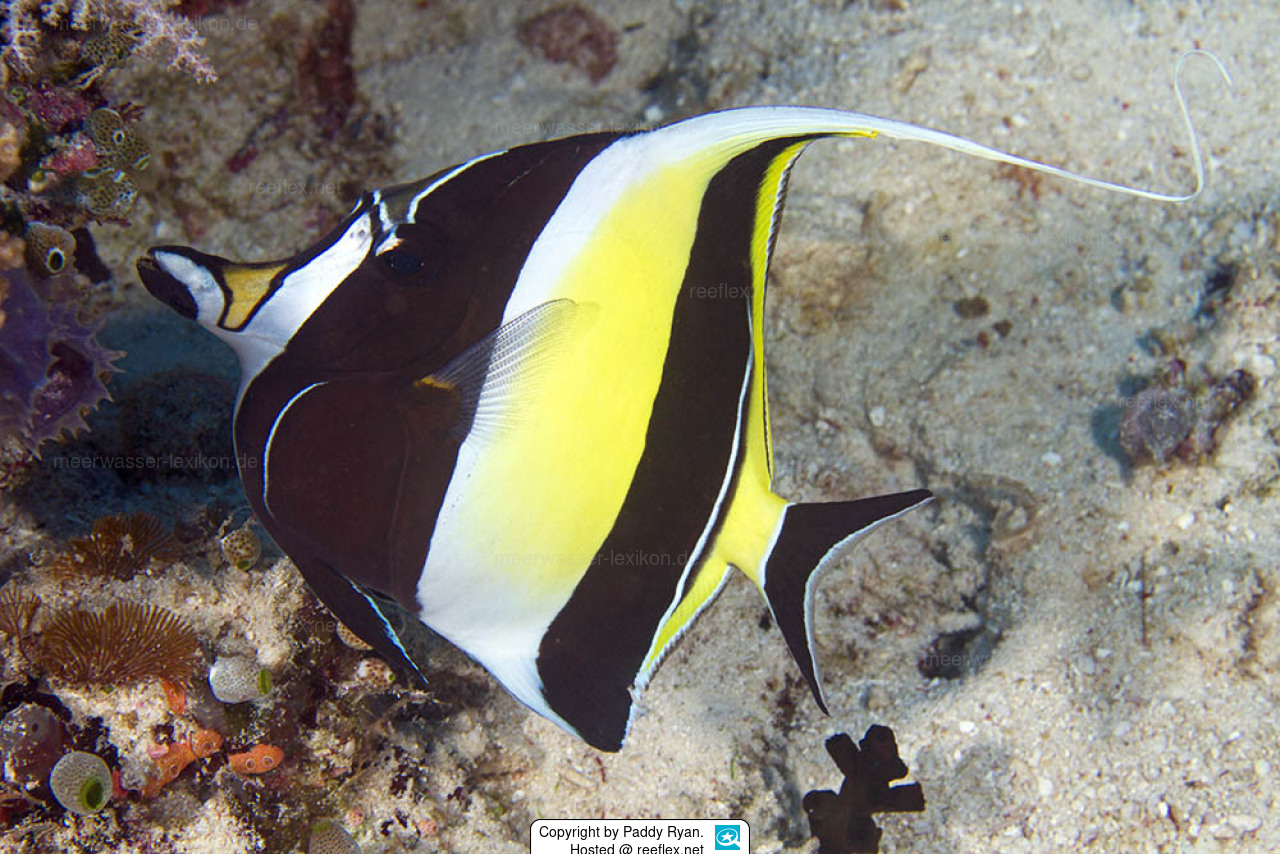Info
(Linnaeus, 1758)
Zanclus cornutus is found up to depths of 180 meters. The family of halterfishes (Zanclidae) is monotypic, therefore it contains only one genus and this then only one species.
Zanclus cornutus feed in nature on sponges, bryozoans, other sessile invertebrates as well as algae. In the sea they usually live in pairs, something that should be implemented in the aquarium - if you really want to keep it.
In our opinion it is not an easy fish to keep and should only be kept by very experienced aquarists. The experiences differ partly considerably, from very easy without problems, up to very difficult. This already starts with the selection of the animal in the pet shop up to the tank structure and co-stocking, as well as food supply.
General information about aquarium keeping.
This fish is not easy in the acclimation and quite sensitive. However, there are reports to the contrary, according to which this fish could be kept in the tank for several years. Joachim Großkopf for example kept a Zanclus cornutus successfully for 7 years. See also other articles by Daniel Heerz. He also writes that it would be possible, at least under certain circumstances, to keep the Zanclus.
From Joachim Großkopf I learned the following, which seems to be important for keeping Zanclus: Basically the same is valid for Zanclus as for Pygoplites (emperor fishes), it depends very much on how they were treated by the exporters and importers. In nature the Zanclus is one of the most common and widespread fishes, it belongs to the algae eaters, but they do not disdain other growth either, it is not specialized on sponges at all.
Unfortunately it is not suitable for reef tanks with hard corals, at most a socialization with soft corals and disc anemones is possible.
Just like the related surgeonfish, it is sensitive to Cryptocarion (spot disease).
In addition, in the aquarium where halter fish should come, there must not be larger fish under any circumstances, then the halter fish show startle behavior, pose the pennant, swim around like that all the time, and do not show feeding behavior. It is all too easy to think that this is normal behavior, but it is not.
Best are the specimens from the Maldives, like Pygoplites, which eat well accustomed already after one or two days "like a pig".
I stress again, there should be no fish in the tank that is the size of the Zanclus, not to mention susceptible to Cryptocarion! The Zanclus cornutus, just like the clownfish and the pallet doctofish, became famous through the movie "Finding Nemo", especially among children.
The species inhabits nearshore and offshore rocky and coral reefs, including lagoons, is often seen in pairs, although it can form larger aggregations.
Synonyms:
Chaetodon canescens Linnaeus, 1758
Chaetodon cornutus Linnaeus, 1758
Zanclus canescens (Linnaeus, 1758)
Zanclus cornotus (Linnaeus, 1758)
Zanclus cornutus is found up to depths of 180 meters. The family of halterfishes (Zanclidae) is monotypic, therefore it contains only one genus and this then only one species.
Zanclus cornutus feed in nature on sponges, bryozoans, other sessile invertebrates as well as algae. In the sea they usually live in pairs, something that should be implemented in the aquarium - if you really want to keep it.
In our opinion it is not an easy fish to keep and should only be kept by very experienced aquarists. The experiences differ partly considerably, from very easy without problems, up to very difficult. This already starts with the selection of the animal in the pet shop up to the tank structure and co-stocking, as well as food supply.
General information about aquarium keeping.
This fish is not easy in the acclimation and quite sensitive. However, there are reports to the contrary, according to which this fish could be kept in the tank for several years. Joachim Großkopf for example kept a Zanclus cornutus successfully for 7 years. See also other articles by Daniel Heerz. He also writes that it would be possible, at least under certain circumstances, to keep the Zanclus.
From Joachim Großkopf I learned the following, which seems to be important for keeping Zanclus: Basically the same is valid for Zanclus as for Pygoplites (emperor fishes), it depends very much on how they were treated by the exporters and importers. In nature the Zanclus is one of the most common and widespread fishes, it belongs to the algae eaters, but they do not disdain other growth either, it is not specialized on sponges at all.
Unfortunately it is not suitable for reef tanks with hard corals, at most a socialization with soft corals and disc anemones is possible.
Just like the related surgeonfish, it is sensitive to Cryptocarion (spot disease).
In addition, in the aquarium where halter fish should come, there must not be larger fish under any circumstances, then the halter fish show startle behavior, pose the pennant, swim around like that all the time, and do not show feeding behavior. It is all too easy to think that this is normal behavior, but it is not.
Best are the specimens from the Maldives, like Pygoplites, which eat well accustomed already after one or two days "like a pig".
I stress again, there should be no fish in the tank that is the size of the Zanclus, not to mention susceptible to Cryptocarion! The Zanclus cornutus, just like the clownfish and the pallet doctofish, became famous through the movie "Finding Nemo", especially among children.
The species inhabits nearshore and offshore rocky and coral reefs, including lagoons, is often seen in pairs, although it can form larger aggregations.
Synonyms:
Chaetodon canescens Linnaeus, 1758
Chaetodon cornutus Linnaeus, 1758
Zanclus canescens (Linnaeus, 1758)
Zanclus cornotus (Linnaeus, 1758)







 Dr. Paddy Ryan, USA
Dr. Paddy Ryan, USA



















